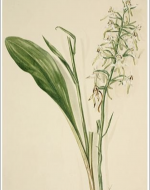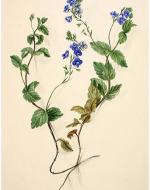Created by Sana Arif on Fri, 03/22/2024 - 00:15
Description:
Margaret Rebecca Dickinson (1821–1918) was a botanical artist residing in north-east England and the Scottish Borders. Her watercolor paintings, drawn from plants gathered around her homes and across the British Isles, are preserved in the archives of esteemed institutions like the Royal Horticultural Society and the Great North Museum: Hancock. Beyond their artistic charm, these paintings offer valuable insights into the historical shifts in land use within the region. Dickinson meticulously assembled a herbarium containing over 1000 specimens and created numerous drawings and watercolor paintings of both wild and cultivated flowers, primarily between 1846 and 1874. While she left no written records of her work, aside from very few field notes, her repertoire consists of 458 watercolor paintings, all of which were donated to the Natural History Society of Northumbria (NHSN). She has evidently devoted significant time and attention to her pursuit, showcasing a remarkable commitment to precision and an adept handling of color. Notably, she presents specimens alongside their shadows, underscoring her mastery of composition and light. Her meticulous records and exceptional artwork distinguish her from the amateur status often associated with collectors or illustrators. Despite the prevalence of flower arrangements and flower pressing as a popular hobby among women during her time, professional involvement for women in the arts remained rare, and Dickinson received little recognition in her lifetime. In 1873, she attained honorary membership in the Berwickshire Naturalists Club, actively contributing her paintings to exhibitions and participating in meetings until 1908. Her travels took her across the British Isles, where she diligently recorded the wildflowers and cultivated flora of the Border Counties. In 2018 she gained recognition by the Natural History Society of Northumbria with a feature in an exhibition/ booklet they made. In 2022, the Granary Gallery created an exhibition titled Margaret Rebecca Dickinson – A Botanical Artist of the Border Counties featuring many of her original pieces. Margaret Rebecca Dickinson's legacy as a botanical artist transcends mere admiration for her exquisite watercolor paintings. Through comparison to modern records, her meticulous documentation and insightful depictions of flora offer invaluable glimpses into historical land use shifts, enriching our understanding of the region's past.
Photograph of Margaret Rebecca Dickinson, Cover of Women Naturalists of North East England Exhibition Booklet, n.d., the Natural History Society of Northumbria. In the summer of 2018, NHSN curated an exhibition spotlighting the often-overlooked narratives of female naturalists. Dr. Claire Jones meticulously crafted seven panels, each revealing the remarkable stories of women such as Margaret Rebecca Dickinson, Mary Jane Hancock, Catharine Hodgkin, Dr. Marie V. Lebour, Dr. Kathleen Blackburn, Evelyn Lobley, and Grace Hickling, the former NHSN secretary. This booklet features reproductions of these panels alongside captivating photographs of the women and their work, including the enigmatic Margaret Rebecca Dickinson, whose image graces the cover. Though the photographer and year of the image remain unknown, its significance is undeniable. This modern booklet serves as a poignant testament to the enduring legacy of Dickinson and her fellow female naturalists, whose contributions were long overlooked but now rightfully celebrated.
Margaret Rebecca Dickinson, No. 83, "The Lesser Butterfly-Orchid," 1848, Margaret Dickinson Gallery, The Victorian Web. Margaret Rebecca Dickinson meticulously captured the elusive beauty of one of the rare specimens collected from the Cirencester area in Kent in 1848. Through her stunning watercolor illustrations. These delicate blooms, once considered rare treasures of the British Isles, are immortalized in Dickinson's artworks, showcasing her keen eye for botanical detail and artistic finesse. By meticulously documenting these orchids, Dickinson not only preserved their exquisite forms but also contributed to the scientific understanding of these elusive species. Her illustrations serve as invaluable records of Kent's floral heritage, offering insights into the region's ecological history and the conservation challenges faced by these orchids. Dickinson's work stands as a testament to her passion for British flora and her enduring legacy as a botanical artist and pioneer in the field of botany.
Margaret Rebecca Dickinson, No. 21, "Germander Speedwell," 1846, Margaret Dickinson Gallery, The Victorian Web. Captured in illustration by Margaret Rebecca Dickinson near Ponteland, Northumbria in 1846, No. 21, Germander Speedwell, is preserved. This flower is special because it is the first of the wildflowers to bloom after winter. It was a fan favorite amongst children. They called the blue flowers “angel eyes” or “birds eyes”. Symbolically, the flowers were meant to wish someone well on their journey. Sir John Everett Millais brings the lovely flowers to light in their most famous depiction through his painting Little Speedwell's Darling Blue, crafted in 1892. Just as Margaret Rebecca Dickinson's meticulous illustrations of botanical wonders allowed for scientific and artistic exploration, Millais's masterpiece exemplifies how her work transcended mere documentation to inspire other artistic endeavors. This symbiotic relationship between botanical illustration and fine art underscores the enduring legacy of both artists, enriching our understanding of nature's beauty and its artistic interpretations across generations.
Margaret Rebecca Dickinson, No. 312, "Foxglove," 1861, Margaret Dickinson Gallery, The Victorian Web. Collected from the picturesque village of Gattonside, nestled near Melrose in the Scottish Borders in the year 1861, Dickinson's illustration of the “Foxglove” emerges as a symbol of enchantment and mystery. According to local lore, these delicate blooms were believed to be frequented by the whimsical 'little folk,' who purportedly rang tiny bells amidst the verdant meadows. This captivating legend even found its way into literature, as evidenced by Jane Eyre's recollection of seeking elves among the flowers in her youth in Charlotte Brontë's Jane Eyre (1847). Thus, beyond its botanical significance, this wildflower weaves a tapestry of magic and imagination, bringing the realms of reality and fantasy into the arts and sciences of our world.





